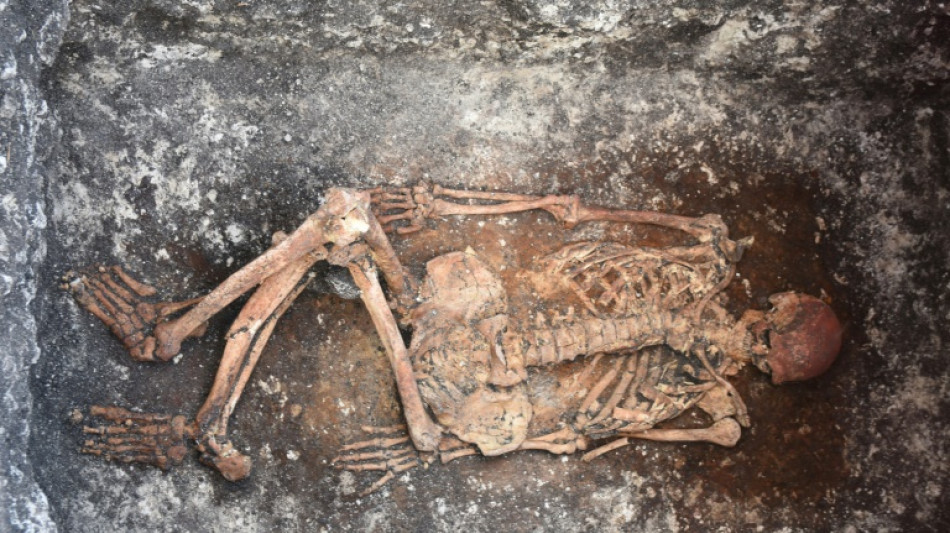
-
 Pakistan police fire tear gas, rubber bullets at pro-Khan supporters
Pakistan police fire tear gas, rubber bullets at pro-Khan supporters
-
Hong Kong same-sex couples win housing, inheritance rights

-
 Indonesia digs out as flooding, landslide death toll hits 20
Indonesia digs out as flooding, landslide death toll hits 20
-
Liverpool's old guard thriving despite uncertain futures

-
 Mbappe takes reins for Real Madrid in Liverpool clash
Mbappe takes reins for Real Madrid in Liverpool clash
-
As AI gets real, slow and steady wins the race

-
 China's Huawei to launch 'milestone' smartphone with homegrown OS
China's Huawei to launch 'milestone' smartphone with homegrown OS
-
Porzingis and Morant make triumphant NBA returns

-
 Hong Kong top court affirms housing, inheritance rights for same-sex couples
Hong Kong top court affirms housing, inheritance rights for same-sex couples
-
Philippines, China clashes trigger money-making disinformation

-
 Most Asian markets drop, dollar gains as Trump fires tariff warning
Most Asian markets drop, dollar gains as Trump fires tariff warning
-
England 'not quivering' ahead of New Zealand Test challenge

-
 Bethell to bat at three on England Test debut against New Zealand
Bethell to bat at three on England Test debut against New Zealand
-
Trump vows big tariffs on Mexico, Canada and China

-
 New Zealand and England to play for Crowe-Thorpe Trophy
New Zealand and England to play for Crowe-Thorpe Trophy
-
Scheffler, Schauffele and McIlroy up for PGA Player of the Year

-
 Trump to face less internal pushback in new term: ex-commerce chief
Trump to face less internal pushback in new term: ex-commerce chief
-
Extreme weather threatens Canada's hydropower future

-
 More than 34,000 register as candidates for Mexico judges' election
More than 34,000 register as candidates for Mexico judges' election
-
Australia ban cycling's Richardson for life after UK defection

-
 Internal displacement in Africa triples in 15 years: monitor
Internal displacement in Africa triples in 15 years: monitor
-
'Remarkable global progress': HIV cases and deaths declining

-
 Social media firms raise 'serious concerns' over Australian U-16 ban
Social media firms raise 'serious concerns' over Australian U-16 ban
-
Tiger to skip Hero World Challenge after back surgery

-
 MLB shifts six 2025 Rays games to avoid weather issues
MLB shifts six 2025 Rays games to avoid weather issues
-
US women's keeper Naeher retiring after Europe matches

-
 West Ham stun Newcastle to ease pressure on Lopetegui
West Ham stun Newcastle to ease pressure on Lopetegui
-
Arteta calls on Arsenal to show 'ruthless' streak on Champions League travels

-
 Israel bids emotional farewell to rabbi killed in UAE
Israel bids emotional farewell to rabbi killed in UAE
-
Sonar image was rock formation, not Amelia Earhart plane: explorer

-
 Tottenham goalkeeper Vicario has ankle surgery
Tottenham goalkeeper Vicario has ankle surgery
-
Green light for Cadillac to join Formula One grid in 2026

-
 Israel to decide on ceasefire as US says deal 'close'
Israel to decide on ceasefire as US says deal 'close'
-
California vows to step in if Trump kills US EV tax credit

-
 Special counsel asks judge to dismiss subversion case against Trump
Special counsel asks judge to dismiss subversion case against Trump
-
Ronaldo double takes Al Nassr to brink of Asian Champions League quarters

-
 Brazil minister says supports meat supplier 'boycott' of Carrefour
Brazil minister says supports meat supplier 'boycott' of Carrefour
-
Steelmaker ArcelorMittal to close two plants in France: unions

-
 Macy's says employee hid up to $154 mn in costs over 3 years
Macy's says employee hid up to $154 mn in costs over 3 years
-
EU grocery shoppers 'fooled' by 'maze' of food labels: audit

-
 Awaiting Commerzbank, Italy's UniCredit bids for Italian rival
Awaiting Commerzbank, Italy's UniCredit bids for Italian rival
-
Alonso jokes about playing return amid Leverkusen injury woes

-
 G7 ministers discuss ceasefire efforts in Mideast
G7 ministers discuss ceasefire efforts in Mideast
-
Bayern need to win all remaining Champions League games, says Kane

-
 Indian cricketer, 13, youngest to be sold in IPL history
Indian cricketer, 13, youngest to be sold in IPL history
-
Beating Man City eases pressure for Arsenal game: new Sporting coach

-
 Argentine court hears bid to end rape case against French rugby players
Argentine court hears bid to end rape case against French rugby players
-
Egypt says 17 missing after Red Sea tourist boat capsizes

-
 Dortmund boss calls for member vote on club's arms sponsorship deal
Dortmund boss calls for member vote on club's arms sponsorship deal
-
Chanel family matriarch dies aged 99: company


Horseback riding may have begun 5,000 years ago in Europe: study
Who were the first people to ride horses?
Researchers believe they have found the earliest evidence of horseback riding, by the ancient Yamnaya people in Europe some 5,000 years ago.
Their conclusions, based on an analysis of human skeletal remains found in Bulgaria, Hungary and Romania, were published on Friday in the journal Science Advances.
Domestication of horses for milk is widely accepted to have begun around 3500 BC to 3000 BC, the study said, but the "origins of horseback riding remain elusive."
The researchers from the University of Helsinki and other European institutions date the earliest horsemanship to 3000 BC to 2500 BC among members of the Yamnaya culture.
"Our findings provide a strong argument that horseback riding was already a common activity for some Yamnaya individuals as early as 3000 BC," the researchers said.
Horse bones have been discovered in Yamnaya settlements but they are not as well preserved as human skeletons, which were given proper burials in earth-covered mounds known as "kurgans."
The researchers said the human skeletons provided the best source of information about horse riding because any riding tack used by early riders would have been made using perishable materials.
The researchers said some of the human skeletons they analyzed bore skeletal traits indicative of what they called "horsemanship syndrome."
"A skeleton of a living person is reacting," Martin Trautmann, a postdoctoral researcher at the University of Helsinki and one of the authors of the study, told AFP.
"If you sit on horseback you need to balance with every step of your mount, you need to cling tightly with your legs."
Doing that repeatedly leaves tell-tale changes in bone morphology, Trautmann said, including "stress-induced vertebral degeneration," a common ailment among avid horse riders.
"We know that saddles and stirrups dated much later," Trautmann said, and the early horse riders were probably riding bareback and gripping the mane of the horse.
- 'Cowboys, not warriors' -
Volker Heyd, a professor of archeology at the University of Helsinki, said the findings "fit very nicely into the overall picture" of Yamnaya culture.
"We were already suspecting them of using horses," Heyd said, and it could help explain the "exceptional" geographic expansion of their society in a few generations.
"It is difficult to envision how this expansion could have taken place without improved means of transport," the researchers said.
"Using horses for transport was a decisive step in human cultural development," they said.
"Trade and cultural exchange as well as conflicts and migrations leapt with the increase in speed and range provided by horsemanship."
The researchers said the Yamnaya were probably not initially using horses for warfare.
"They were cowboys, not warriors," said Trautmann.
Heyd said the early horse riders "were probably helping the Yamnaya people in guarding their animals, their cattle and sheep mostly."
According to the researchers, the earliest figurative evidence of horse riding comes from the Mesopotamian Ur III period shortly before 2000 BC through depictions of a horse and rider.
Images and mentions in cuneiform texts of horseback riding are also found in the Old Babylonian period from around 1880 BC to 1595 BC.
F.Moura--PC




